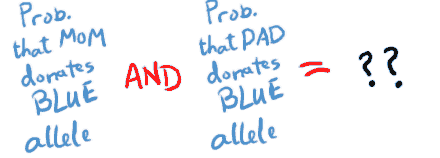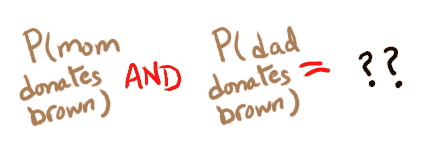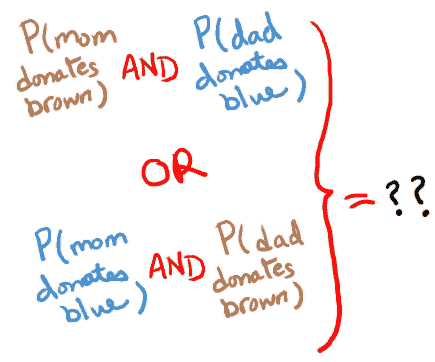Scribbling in the margin of his book, the Assistant soon had the answer his supervisor was waiting for. His reasoning went something like this...
>Episode 2: Hardy and Weinberg to the rescue
Exact probabilities
For a given, single locus:
- let p be the proportion of dominant alleles (brown hair) in the gene pool
- let q be the proportion of recessive alleles (blue hair) in the gene pool
Using p and q, we can formalize the calculations you made a few pages ago. Remember the laws of AND and OR? Here are the same formulas, but when you roll the mouse over the graphics, you'll see the notation with p and q instead of numbers.
First, what is the probability that an offspring gets 2 blue alleles?
And the probability that the offspring will be all-brown (no blue allele)?
And finally, the probability that the offspring will be a blue carrier?
So to summarize, assuming the random mating occurs
- the proportion of homozygous dominant genotypes = p*p = p2
- the proportion of heterogeneous genotype (carriers) = p*q + q*p = 2pq
- the proportion of homozygous recessive genotypes = q*q = q2.
"Neat-o" muttered the Assistant with self-aware irony. "Using p and q, I can avoid all the gobbledy-gook about probability. I just need to remember p2 for the dominant genotype, 2pq for the carriers, and q2 for the recessive type. Pretty simple. I bet if I tried, I could even forget where it came from..." But first, the Assistant shot off a triumphant email to the ME: |
Fill in the blanks (you may need a calculator)
Turn on javascript to make this element interactive!
Sir: if 22% of the allele pool is the recessive gene
( in other words, p =
and q =
), then, with 2 decimal places,
- % of the population would be expected to be carriers, and
- % would be expected to have blue hair.
In other words, rounded to no decimal places, I predict the following distribution:
% /
% /
% .
p.s., Did you know Google can be used as a calculator? Just type your equation with a equals sign,
i.e., .22 * .22 =, in the search box. Neat-o.
Copyright University of Maryland, 2007
You may link to this site for educational purposes.
Please do not copy without permission
requests/questions/feedback email: admin@mathbench.umd.edu


